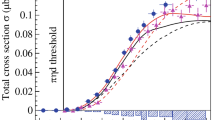Summary
An experimental analysis of the process

is presented. Theσ(−)/σ(+) ratio has been measured in the photon energy interval (170÷230) MeV and Lab. angles 45°, 75°, 105°, 150°. The results are interpreted on the base of the impulse approximation with the aim of getting information on the processhv+n →π −+p.
Riassunto
Viene presentata un’analisi sperimentale del processo

Il rapportoσ(−)/σ(+) è stato misurato nell’intervallo di energia dei fotoni compreso tra 170 e 230 MeV. I risultati sono stati esaminati usando l’«impulse approximation» con lo scopo di ottenere informazioni sul processohv+n → π−+p.
Similar content being viewed by others
References
e.g. G. F. Chew andF. W. Low:Phys. Rev.,101, 1579 (1956).
K. Watson:Phys. Rev.,85, 852 (1952).
I. L. Lebow, B. T. Feld, D. H. Frisch andL. S. Osborne:Phys. Rev.,85, 681 (1952);R. M. Littauer andD. Walker:Phys. Rev.,86, 838 (1952);S. White, M. J. Jacobson andA. G. Schulz:Phys. Rev.,88, 836 (1952);J. L. Jenkins, D. Luckey, T. R. Palfrey andR. R. Wilson:Phys. Rev.,95, 179 (1954);M. Sands, J. G. Teasdale andR. L. Walker:Phys. Rev.,95, 592 (1954);D. C. Hagerman, K. M. Crowe andR. M. Friedman:Phys. Rev.,106, 818 (1957).
M. Beneventano, G. Bernardini, D. Carlson-Lee, G. Stoppini andL. Tau:Nuovo Cimento,4, 323 (1956) — hereafter referred to as I.
A. Beneventano, G. Bernardini, G. Stoppini andL. Tau:CERN Symposium,2, 259 (1956). For other references see ref. (4).
See, for example,M. J. Moravsič:Nuovo Cimento,7, 442 (1958).
G. Bernardini andE. L. Goldwasser:Phys. Rev.,94, 729 (1954).
E. A. Whalin, Jr. andR. A. Reitz:Rev. Sec. Instr.,26, 59 (1955).
M. Beneventano, G. Bernardini, D. Carlson-Lee, E. L. Goldwasser andG. Stoppini:Nuovo Cimento,12, 156 (1954).
L. Ferretti andM. Manaresi:Nuovo Cimento,1, 512 (1955).
G. F. Chew andG. C. Wick:Phys. Rev.,85, 636 (1952);G. F. Chew andM. L. Goldberger:Phys. Rev.,87, 778 (1952).
R. Hofstadter andR. W. McAllister:Phys. Rev.,98, 217 (1955);R. Hofstadter andR. W. McAllister:Phys. Rev.,103, 1454 (1956).
L. M. Lederman andK. C. Rogers:Phys. Rev.,105, 247 (1957).
G. Chew andH. Lewis:Phys. Rev.,84, 779 (1951).
H. Gartenhaus:Phys. Rev.,100, 900 (1955).
Proceedings of the VII Annual Rochester Conference on High-energy Physics, (1957).
G. Morpurgo:Nuovo Cimento,7, 855 (1950);M. Lax andH. Feshbach:Phys. Rev.,81, 189 (1951);88, 509 (1952);G. Chew andH. Lewis:Phys. Rev.,84, 779 (1951);S. Machida andT. Tamura:Prog. Theor. Phys.,6, 572 (1951);W. Thirring:Helv. Phys. Acta,26, 465 (1953);A. M. Baldin:Comp. Rend. CERN Symposium,2, 272 (1956);S. Penner:Phys. Rev.,105, 1113 (1957).
R. Wilson:Phys. Rev.,104, 218 (1956).
L. Allen:Phys. Rev.,98, 705 (1955);B. D. Schriever andA. O. Hanson:Phys. Rev.,101, 377 (1955);J. Keck, R. M. Littauer, G. K. O’Neill, A. M. Perry andW. M. Woodward:Phys. Rev.,93, 827 (1954);J. Keck andA. Tollestrup:Phys. Rev.,101, 360 (1955).
M. I. Adamovič, V. I. Veksler, G. V. Kuzmičeva, V. G. Larionova andS. P. Harlamov:Comp. Rend. CERN Symposium,2, 265 (1956).
See in particular Table III on page 270 of paper Ref. (20).
M. Gell-Mann andK. M. Watson:Annual Review of Nuclear Science,4, 219 (1954);K. M. Watson et al. ref. (24).
It may be noticed that the approximations involved in the calculations of the curves presented byHagerman et al. tend to exaggerate appreciably the actual difference between the two extreme cases |L|2/|K|2=0 and |K|2|L|2=0.
See ref. (17). The Penner points have been averaged over intervals wider than those used by the author.
D. Carlson-Lee, G. Stoppini andL. Tau:Nuovo Cimento,2, 162 (1955).
E. A. Whalin, B. D. Schriever andA. O. Hanson:Phys. Rev.,101, 377 (1956).
K. M. Watson, J. C. Keck, A. V. Tollestrup andR. L. Walker:Phys. Rev.,101, 1159 (1956);L. J. Koester, Jr. andF. E. Mills:Phys. Rev.,105, 1900 (1957).
E. Fermi:Zeits. für Phys.,88, 116 (1934).
A. M. Baldin:Nuovo Cimento,8, 569 (1958).
G. F. Chew, M. L. Goldberger, F. E. Low andY. Nambu:Phys. Rev.,106, 1345 (1957).
The effective numerical evaluations of the cross-sections, starting from the quite complicated amplitudes given byChew et al., have been worked out by one of us (M. Beneventano) and then checked on many points by the other authors of this paper. Some checks have also been done comparing these calculations with some of those accomplished byE. Goldwasser. In spite of the fact that we do not exclude the occurrence of some mistake and some wrong sign in this very long and tedious work, we believe that the calculated curves represent the predictions of the dispersion relations without substantial errors.
The authors are very indebted to Dr.C. Robinson, Physics Department, University of Illinois, who notified them of some possible misunderstanding in the meaning of the «standard conditions» of the monitor used by them during the performance of the experiment.
It was already shown (5) that theS-wave recoil termR can be derived from the bulk of our results in a way which is certainly much less affected by the very low energy values than considering, for instance, the data atθ=90° only.
M. I. Adamovič, G. V. Kuzmičeva, V. G. Larionova andS. P. Harlamov, Preprint kindly sent by authors.
In the CERN Report of the 1958 Conference, p. 61,Goldwasser argued that the Russian authors used the Illinoisdeuterium data. Actually this was not the case.
See, for instance,Cassels’ report on the 1957 Rochester Conference and ref. (28).
M. Cini, R. Gatto, E. L. Goldwasser andM. A. Ruderman:Nuovo Cimento 10, 242 (1958).
G. Puppi: CERN Report of the 1958 Conference, p. 49 and following.
Author information
Authors and Affiliations
Rights and permissions
About this article
Cite this article
Beneventano, M., Bernardini, G., Stoppini, G. et al. Photoproduction of charged pions in deuterium. Nuovo Cim 10, 1109–1142 (1958). https://doi.org/10.1007/BF02859573
Received:
Published:
Issue Date:
DOI: https://doi.org/10.1007/BF02859573



